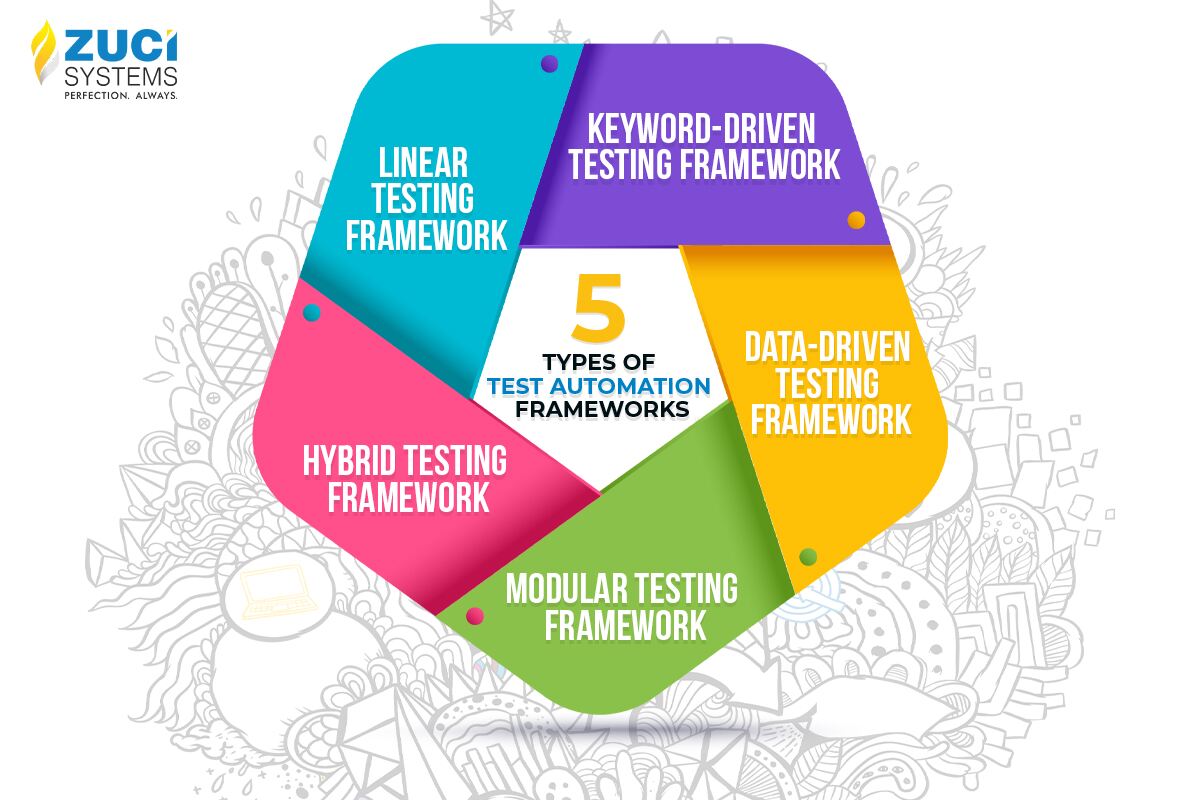Reading Time : 1 Mins
Top Test Automation Frameworks and Best Practices
Minna is a content developer specializing in software testing and Robotic Process Automation (RPA). She enjoys exploring the intricacies of cutting-edge software and knits comprehensible content that resonates with the audience. PS, she is a book lover.
In a fast-paced world where software drives innovation, how do you ensure the quality of your applications while keeping up with the speed of development? Test automation frameworks are the answer. Test automation frameworks play a pivotal role in reducing the most common production bug – 60% of which result from deploying untested and broken code.
Test automation framework is the architectural backbone of any automation testing as it structures the entire workflow with a set of guidelines, practices, and tools that streamline and standardize the process of automating tests. These frameworks play a critical role in software development and quality assurance by improving efficiency, accuracy, and speed.
Types of Test Automation Frameworks
Want to know how to build a scalable test automation framework for your project – Check it out here!
List of Top Test Automation Frameworks
Digital world is expanding like right now, so does testers face growing challenges in maintaining software quality. However, an effective test framework can simplify this process. So here we can some best test automation frameworks that can be your trusted allies in the quest for quality assurance.
Starts here!
1.Selenium
Selenium requires no introduction among testers because with nineteen years of successful journey, it has marked its name in the list of best test automation framework.
With the increasing demand for Selenium, it expanded five components: Selenium IDE for test development, Selenium Client API for multi-language test creation, Selenium Remote Control (RC), Selenium WebDriver, and Selenium Grid.
Features:
- Versatile scripting languages, OS, browser, and integration options expand test coverage for highly reliable web applications.
- Selenium test scripts are compatible with Java, Python, C#, PHP, Ruby, Perl, and .Net, enabling testers to work without language limitations.
- It supports Windows, macOS, and Linux, and is compatible with Mozilla Firefox, Internet Explorer, Chrome, Safari, and Opera browsers, facilitating robust cross-browser compatibility testing across multiple environments.
- The record and replay feature enable to create automated tests without the necessity of learning programming languages.
- The merging of WebDriver with Selenium greatly enhances functionality, enabling direct browser interaction without requiring server installation.
2. Cypress
Cypress, an open-source platform, offers a full end-to-end testing solution, equipped with numerous features for conducting Cypress automation testing. It is known for its exceptional speed and efficiency in front-end testing, and it leverages JavaScript, which places it among the top test automation frameworks.
Features:
- Cypress allows you to intercept and modify network requests, making it suitable for testing API interactions.
- With a user-friendly syntax design, it is easier for both developers and testers to write test scripts.
- It automatically reloads the browser when changes are made, providing instant feedback.
- It can be quickly set up with minimal dependencies, making it accessible to a wide range of users.
- It can be easily integrated into CI/CD pipelines to automate testing in the software development process.
- You can extend Cypress’s functionality through various plugins and extensions available in the Cypress ecosystem.
3.Appium
Appium is a versatile and robust open-source test automation framework that is primarily used for mobile app testing. It provides a standardized, cross-platform approach to automation, making it accessible through multiple programming languages and offering features essential for comprehensive testing and quality assurance in the mobile app development process.
Features:
- Provides support for multiple development languages through Remote WebDriver language bindings (Java, JavaScript, Perl, Python, C#).
- Appium as a cross-platform automation framework, allows you to use a single API for running tests on multiple platforms and operating systems, which significantly improves code reusability.
- It eliminates recompilation as a result testers need not recompile the mobile application every time, they run the automation tests.
- Appium provides a variety of locator strategies to find and interact with elements in the app, including XPath, ID, name, class, accessibility ID, and more.
- It supports a wide range of real devices and emulators/simulators, making it flexible for testing across different devices and OS versions.
4. WebDriver IO
Webdriver IO, the next candidate for the best test automation framework, is a cutting-edge automation framework, designed for streamlining the testing of modern web and mobile applications. It offers simplified app interaction and a wide array of plugins to build a scalable and reliable test suite, facilitating easy integration and customization.
Features:
- Like other test automation frameworks, WebdriverIO allows you to automate tests across various web browsers, such as Chrome, Firefox, Safari, and Microsoft Edge. It also supports headless browser testing.
- Supports synchronous and asynchronous test execution, making it easier to write and manage test scripts.
- Allows to create and use custom selectors, making it easier to locate and interact with elements using unique criteria.
- Encourages the use of the Page Object Model design pattern to create maintainable and reusable test code by separating the page structure from test logic.
- Provides hooks and events for setup and teardown actions, as well as custom event handling, allowing you to extend and customize test behavior.
- You can use WebdriverIO to test web applications on different operating systems, including Windows, macOS, and Linux.
- WebdriverIO has an active community and supports a wide range of plugins and extensions that enhance its functionality and integrate with other tools.
- Also works well with Docker containers, making it easier to set up test environments and ensure consistency across different testing setups.
5. Robot Framework
Robot Framework, an open-source and versatile automation framework, serves both test automation and robotic process automation (RPA). Its open and extensible nature allows seamless integration with a wide range of tools, enabling powerful and cost-effective automation solutions, all without licensing expenses.
Features:
- The framework organizes tests into a hierarchy with nested test suites, and test data is stored in files within directories.
- It employs a straightforward tabular format for test data and follows a keyword-driven testing methodology, making it user-friendly.
- Supports the use of libraries created in various programming languages like Python, Java, and more.
- Robot Framework is complemented by a diverse ecosystem of libraries and tools, often developed as standalone projects.
6. Cucumber
Cucumber is a top choice for automating tests because it uses a language called Behavior-Driven Development (BDD). This makes it easier to create automated tests that match the way people think about a system’s behavior.
Features:
- Cucumber is accessible on a variety of platforms, encompassing Windows, Mac, and Linux.
- Cucumber is compatible with languages like Ruby, Java, and .NET.
- It does not require learning complex programming languages.
- Cucumber encourages code reuse through the creation of generic code that can be applied across multiple platforms.
- The automation testing framework’s code is highly readable, making it accessible to individuals from diverse teams. This improves the quality of the tests and encourages collaboration.
7. EarlGrey
EarlGrey is a specialized iOS native app testing framework, focusing on automation testing of the app’s user interface. It seamlessly integrates with the XCUITest framework and requires test scripts to be written in Objective-C or Swift.
Features:
- EarlGrey is a white box testing tool, allowing tests to query the application directly.
- It offers automatic synchronization with UI, network requests, and system queues. Additionally, it provides synchronization control APIs for managing synchronization behavior, enhancing test stability.
- It uses screenshot comparison to make sure that UI elements are visible before it interacts with them, ensuring that users can see and interact with the UI being tested.
- It provides realistic user interactions, like taps and swipes, by checking if elements are genuinely visible. This helps uncover and address user-facing issues in the app.
- It ensures the stability of UI components before conducting tests, resulting in highly reliable tests.
- EarlGrey can be directly utilized within Xcode, making it easier for developers and testers to create, run, and manage UI tests.
8. Citrus
Citrus is a unique automation framework designed for testing APIs and communication channels. It offers seamless integration with various messaging protocols and data formats, making it an essential choice for communication testing in projects involving HTTP, REST, or JMS.
Features:
- Citrus offers versatile message-based testing capabilities with extensive control over test flow and protocol support.
- The framework has comprehensive test management and integration capabilities, from test grouping and parallel execution to IDE and build lifecycle support.
- Helps to create clear and easily maintained tests in human-readable XML format with environment separation for effective testing.
- Provides built-in features to validate data existence, simulate database content, execute queries and readable tests.
- It has human-readable tests in XML format, ensuring that your tests are easily comprehensible and manageable.
9. Robotium
Robotium, the go-to Android Test Automation framework, simplifies UI automation scripting for both native and hybrid Android apps. Its capabilities extend to functional, system, and user acceptance testing, making it a comprehensive test automation framework choice for Android app development.
Features:
- Enables the creation of robust test cases even with limited knowledge about the tested application.
- Provides APIs for direct interaction with Android app UI controls like EditText, TextView, and Button.
- It seamlessly integrates with both Maven and Ant, simplifying the inclusion of Robotium in your project’s build automation.
- It is compatible with various code coverage measurement tools like Cobertura and Emma.
- Robotium test cases are notably more readable when compared to typical instrumentation tests.
- The latest Robotium versions offer support for hybrid applications, which utilize WebViews to display HTML and JavaScript files in full screen, leveraging the native browser rendering engine.
10. Serenity
Serenity, or Serenity BDD, is an open-source library for writing comprehensive regression and acceptance tests. It’s primarily Java-based but extends its reach with SerenityJS, catering to the preferences of front-end developers, making it a top choice among test automation frameworks.
Features:
- Serenity makes testing easier by harnessing the capabilities of existing frameworks and includes native support for web testing with Selenium.
- It leverages RestAssured for REST API testing, while the Screenplay pattern enhances test maintainability.
- Serenity comes with a lot of in-built integrations.
- It facilitates parallel execution of tests.
- The framework provides in-depth reports, which includes detailed insights and analysis of test results and execution.
Best Test Automation Framework Practices
If you are down to select an apt test automation framework for your project, and not sure what to look in for, happy to be your guide. I’ve compiled a list which might help you to pick out the right test automation framework that perfectly fits your project.
1. Modularity and Reusability
Software applications continually evolve to meet changing demands and updates. By utilizing reusable modules across test cases, scenarios, and new projects, time is saved, redundancy is reduced, and code updates are simplified. This minimizes the risk of defects, ensures consistency, and mitigates errors arising from duplicated code.
2. Test Data Management
Conducting test scenarios often necessitates specific sets of data, such as testing the login functionality of a webpage. While the focus of testing is on assessing the functionality of a given task, the test automation framework plays a crucial role in this process.
The test automation framework is responsible for ensuring that the required data is readily available to simulate realistic scenarios. Additionally, it must guarantee the consistent reproducibility of test scenarios. In some cases, data isolation may be necessary for privacy and security reasons.
It is the responsibility of the test automation framework to manage data masking and obfuscation techniques, safeguarding privacy and ensuring compliance with data protection regulations.
3. Continuous Integration
In the fast-paced software market, every second counts. Continuous Integration (CI) is an essential practice that should be a fundamental part of your test automation framework. CI involves the automatic integration of code changes into a shared repository, coupled with the execution of automated tests. This early testing helps in detecting defects and issues as soon as they are introduced.
As a chain reaction, CI accelerates the feedback loop and upholds code quality by adhering to established standards and regulations. Consequently, it enables the swift and reliable release of software products onto the market.
4. Framework Extensibility
It’s always safe to leave room for future advancement because we are talking about the software market, where everything needs to be perfect for our customers. If your test automation framework is extensible, the easier it is to add on specific needs of your organization. It can be custom libraries, integrations, or plugins to address unique testing challenges.
Extensibility future-proofs your testing infrastructure. It ensures that your framework can evolve along with the changing demands of your projects and the industry as a whole.
5. Test Environment Management
Test Environment Management is a critical component of a test automation framework as it ensures that tests are conducted under known and controlled conditions, minimizing unexpected variables that could lead to inaccurate test results.
In scenarios where multiple test environments are necessary, effective management allows tests to run in parallel in different environments. Additionally, the capacity to rapidly create, clone, or scale test environments becomes indispensable as testing requirements expand.
6. Scalability and Performance
As a software project evolves, the number of test cases often grows. A scalable framework can accommodate the increasing volume of test cases without a significant increase in maintenance effort. It ensures that testing can continue efficiently as the application becomes more complex.
Wondering how to build a scalable framework? Hear from our SDET Manager.
Well, adding performance testing tools in test automation framework makes your software product more predictable in respect to foreseeing bottleneck issues and optimizes application performance under various circumstances.
7. Error Handling and Reporting
In test automation, it’s not just about presenting results; it’s about how we handle errors. A well-structured error handling system keeps tests running while gathering detailed error data. This helps testers and developers quickly pinpoint issues and expedite troubleshooting.
So, what can a framework offer? Flexibility lets testers define custom actions for specific errors, whether it’s refreshing a page, re-logging in, or gracefully moving to the next test case, depending on the error context.
Wrapping up:
Test automation frameworks play a crucial role in enhancing the dependability and consistency of test scripts. They offer a range of types and approaches that can be tailored to suit the requirements of diverse projects. But the best practices remain constant for any framework you choose, because they are fundamental and make your framework effective for business requirements.
Not sure how to effectively strategize your testing? Be our guest to talk to our testing experts and learn where you can leverage automation.
Related Posts























